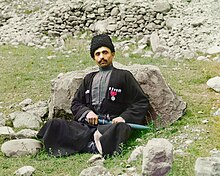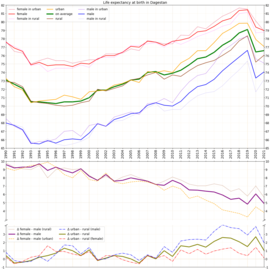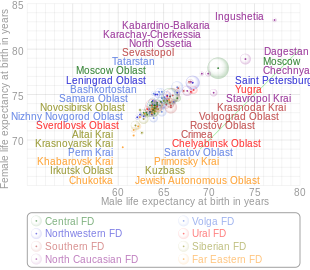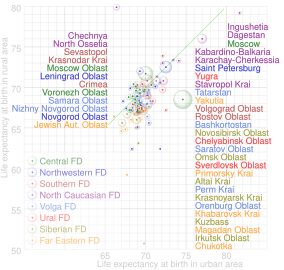A | B | C | D | E | F | G | H | CH | I | J | K | L | M | N | O | P | Q | R | S | T | U | V | W | X | Y | Z | 0 | 1 | 2 | 3 | 4 | 5 | 6 | 7 | 8 | 9
Republic of Dagestan | |||||||||||||||||||||||||||
|---|---|---|---|---|---|---|---|---|---|---|---|---|---|---|---|---|---|---|---|---|---|---|---|---|---|---|---|
| Республика Дагестан 13 other official names
| |||||||||||||||||||||||||||
| Anthem: "State Anthem of the Republic of Dagestan" | |||||||||||||||||||||||||||
 Location of Dagestan (red) within European Russia | |||||||||||||||||||||||||||
| Coordinates: 42°59′2″N 47°30′18″E / 42.98389°N 47.50500°E | |||||||||||||||||||||||||||
| Country | Russia | ||||||||||||||||||||||||||
| Federal district | North Caucasian[1] | ||||||||||||||||||||||||||
| Economic region | North Caucasus[2] | ||||||||||||||||||||||||||
| Capital | Makhachkala | ||||||||||||||||||||||||||
| Government | |||||||||||||||||||||||||||
| • Body | People's Assembly[3] | ||||||||||||||||||||||||||
| • Head[3] | Sergey Melikov | ||||||||||||||||||||||||||
| Area | |||||||||||||||||||||||||||
| • Total | 50,270 km2 (19,410 sq mi) | ||||||||||||||||||||||||||
| • Rank | 52nd | ||||||||||||||||||||||||||
| Population | |||||||||||||||||||||||||||
| • Total | 3,182,054
| ||||||||||||||||||||||||||
| • Estimate (2018)[6] | 3,063,885 | ||||||||||||||||||||||||||
| • Rank | 10th | ||||||||||||||||||||||||||
| • Urban | 45.2% | ||||||||||||||||||||||||||
| • Rural | 54.8% | ||||||||||||||||||||||||||
| Time zone | UTC+3 (MSK | ||||||||||||||||||||||||||
| ISO 3166 code | RU-DA | ||||||||||||||||||||||||||
| License plates | 05 | ||||||||||||||||||||||||||
| OKTMO ID | 82000000 | ||||||||||||||||||||||||||
| Official languages | Russian;[8] [9][10] | ||||||||||||||||||||||||||
| Website | http://www.e-dag.ru/ | ||||||||||||||||||||||||||



Dagestan (⫽ˌdæɡɪˈstæn, -ˈstɑːn⫽ DAG-ə-STA(H)N; Russian: Дагестан; IPA: [dəɡʲɪˈstan]), officially the Republic of Dagestan,[a] is a republic of Russia situated in the North Caucasus of Eastern Europe, along the Caspian Sea. It is located north of the Greater Caucasus, and is a part of the North Caucasian Federal District. The republic is the southernmost tip of Russia, sharing land borders with the countries of Azerbaijan and Georgia to the south and southwest, the Russian republics of Chechnya and Kalmykia to the west and north, and with Stavropol Krai to the northwest. Makhachkala is the republic's capital and largest city; other major cities are Derbent, Kizlyar, Izberbash, Kaspiysk, and Buynaksk.
Dagestan covers an area of 50,300 square kilometres (19,400 square miles), with a population of over 3.1 million,[12] consisting of over 30 ethnic groups and 81 nationalities.[13] With 14 official languages, and 12 ethnic groups each constituting more than 1% of its total population, the republic is one of Russia's most linguistically and ethnically diverse, and one of the most heterogeneous administrative divisions in the world.[14] Most of the residents speak one of the Northeast Caucasian, or Turkic, languages;[13] however, Russian is the primary language and the lingua franca in the republic.[15]
Toponymy
The word Dagestan is of Turkish and Persian origin, directly translating to "Land of the Mountains". The Turkish word dağ means "mountain", and the Persian suffix -stan means "land".
Some areas of Dagestan were known as Lekia, Avaria and Tarki at various times.[16]
Between 1860 and 1920, Dagestan was referred to as Dagestan Oblast, corresponding to the southeastern part of the present-day republic. The current borders were created with the establishment of the Dagestan Autonomous Soviet Socialist Republic in 1921, with the incorporation of the eastern part of Terek Oblast, which is not mountainous but includes the Terek littoral at the southern end of the Caspian Depression.
Names in its official languages
- Russian – Республика Дагестан (Respublika Dagestan)
- Avar – Дагъистан Республика (Daġistan Respublika)
- Dargin – Дагъистан Республика (Daġistan Respublika)
- Kumyk – Дагъыстан Жумгьурият (Республика) (Dağıstan Cumhuriyat / Respublika)
- Lezgian – Республика Дагъустан (Respublika Daġustan)
- Lak – Дагъусттаннал Республика (Daġusttannal Respublika)
- Tabasaran – Дагъустан Республика (Daġustan Respublika)
- Rutul – Республика Дагъустан (Respublika Daġustan)
- Aghul – Республика Дагъустан (Respublika Daġustan)
- Tsakhur – Республика Дагъустан (Respublika Daġustan)
- Nogai – Дагыстан Республикасы (Dağıstan Respublikası)
- Chechen – Дегӏестан Республика (Deġestan Respublika)
- Azerbaijani – Дағыстан Республикасы (Dağıstan Respublikası)
- Tat – Республикей Догъисту (Respublikei Doġistu)
Geography
- the North Caucasus Federal District's republics: Karachay-Cherkessia, Kabardino-Balkaria, North Ossetia-Alania, Ingushetia, Chechnya and Dagestan
- to the north and west: the Southern Federal District
The republic is situated in the North Caucasus mountains. It is the southernmost part of Russia and is bordered on its eastern side by the Caspian Sea.
- Area: 50,300 square kilometers (19,400 sq mi)
- Borders:
- internal: Kalmykia (N), Chechnya (W), and Stavropol Krai (NW)
- international: Azerbaijan (Balakan District, Khachmaz District, Oghuz District, Qabala District, Qakh District, Qusar District, Shaki District and Zaqatala District) (S), Georgia (Kakheti) (SW)
- water: Caspian Sea (E)
- Highest point: Mount Bazardüzü/Bazardyuzyu: 4,446 metres (14,587 ft)
- Maximum north–south distance: 400 kilometers (250 mi)
- Maximum east–west distance: 200 kilometers (120 mi)
Rivers
There are over 1,800 rivers in the republic. Major rivers include:
- Sulak River
- Samur River
- Terek River
- Avar Koisu
- Andi Koisu
- Kazi-Kumukh Koisu
Lakes
Dagestan has about 405 kilometers (252 mi) of coastline on the world's largest lake, the Caspian Sea.
Mountains
Most of Dagestan is mountainous, with the Greater Caucasus Mountains covering the south of the republic. The highest point is the Bazardüzü/Bazardyuzyu peak at 4,470 meters (14,670 ft), on the border with Azerbaijan. The southernmost point of Russia is located about seven kilometers southwest of the peak. Other important mountains are Diklosmta (4,285 m (14,058 ft)), Gora Addala Shukgelmezr (4,152 m (13,622 ft)) and Gora Dyultydag (4,127 m (13,540 ft)). The town of Kumukh is one of the settlements on the mountains.
Natural resources
Dagestan is rich in oil, natural gas, coal, and many other minerals.[17]
Climate
The climate is classified as a continental climate, with a significant lack of precipitation. It is among the warmest places in Russia. In the mountainous regions, it is subarctic.[citation needed]
- Average January temperature: +2 °C (36 °F)
- Average July temperature: +26 °C (79 °F)
- Average annual precipitation: 250 mm (10 in) (northern plains) to 800 mm (31 in) (in the mountains).[18]
Administrative divisions
Dagestan is divided into forty-one administrative districts (raions) and ten cities/towns. The districts are further subdivided into nineteen urban-type settlements, and 363 rural okrugs and stanitsa okrugs.
History

In the first few centuries AD, Caucasian Albania (corresponding to modern Azerbaijan and southern Dagestan) became a vassal and eventually subordinate to the Parthian Empire. With the advent of the Sasanian Empire, it became a satrapy (province) within the vast domains of the empire. In later antiquity, a few wars were fought as the Roman Empire unsuccessfully attempted to contest Sasanid rule over the region. Over the centuries, to a relatively large extent, the peoples within the Dagestan territory converted to Christianity alongside Zoroastrianism.
In the 5th century, the Sassanids gained the upper hand, and by the 6th century had constructed a strong citadel at Derbent, known from then on as the Caspian Gates, while the Huns overran the northern part of Dagestan, followed by the Caucasian Avars. During the Sassanian era, southern Dagestan became a bastion of Persian culture and civilization, with its center at Derbent.[19] A policy of "Persianisation" can be traced over many centuries.[20]
Islamic influence
During the Islamic conquests, the Dagestani people (region of Derbent) were the first people to become Muslims within current Russian territory, after the Arab conquest of the region in 643.[21] In the 8th century Arabs repeatedly clashed with the Khazars. Although the local population rose against the Arabs of Derbent in 905 and 913, Islam was still adopted in urban centers, such as Samandar and Kubachi (Zerechgeran), from where it steadily diffused into the highlands. By the 15th century, Christianity had died away, leaving a 10th-century Church of Datuna as the sole monument to its existence.
Seljuk Turks

In the second half of the 11th century, the Seljuk Turks took part of the region of Dagestan under their control.[22]
Mongol rule
The Mongols raided the lands in 1221–1222 then conquered Derbent and the surrounding area from 1236 to 1239 during the invasions of Georgia and Durdzuketia.
Timurids
The Timurids incorporated the region into their realm following the Mongols.[22]
Alternating Persian and Russian rule

As Mongolian authority gradually eroded, new centers of power emerged in Kaitagi and Tarki. In the early 16th century, the Persians (under the Safavids) reconsolidated their rule over the region, which would, intermittently, last till the early 19th century. In the 16th and 17th centuries, legal traditions were codified, and mountainous communities (djamaats) obtained considerable autonomy. In the 1720s, as a result of the disintegration of the Safavids and the Russo-Persian War (1722–23), the Russians briefly annexed maritime Dagestan from the Safavids. The Russians could not hold on to the interior of Dagestan, and could only be stopped in front of Baku with the help of Ottoman forces under the command of Mustafa Pasha. With a treaty signed between Russia and the Ottoman Empire in 1724, aimed at dividing the territories of Safavid Iran between them, Derbend, Baku and some other places in the region were left to Russia. Dagestan briefly came under Ottoman rule between 1578 and 1606.[22]
The territories were however returned to Persia in 1735 per the Treaty of Ganja.
Between 1730 and the early course of the 1740s, following his brother's murder in Dagestan, the new Persian ruler and military genius Nader Shah led a lengthy campaign in swaths of Dagestan in order to fully conquer the region, which was met with considerable success, although eventually he was forced to withdraw due to the extremity of the weather, the outbreak of disease and heavy raids by the various ethnic groups of Dagestan, forcing him to retreat with his army. From 1747 onwards, the Persian-ruled part of Dagestan was administered through the Derbent Khanate, with its center at Derbent. The Persian expedition of 1796 resulted in the Russian capture of Derbent in 1796. However, the Russians were again forced to retreat from the entire Caucasus following internal governmental problems, allowing Persia to capture the territory again.
Russian rule consolidated
It was not until the aftermath of the Russo-Persian War (1804–1813) that Russian power over Dagestan was confirmed, and that Qajar Persia officially ceded the territory to Russia. In 1813, following Russia's victory in the war, Persia was forced to cede southern Dagestan with its principal city of Derbent, alongside other vast territories in the Caucasus to Russia, conforming with the Treaty of Gulistan.[23] The 1828 Treaty of Turkmenchay indefinitely consolidated Russian control over Dagestan and removed Persia from the military equation.[24]
Uprisings against imperial Russia


The Russian administration, however, disappointed and embittered the highlanders. The institution of heavy taxation, coupled with the expropriation of estates and the construction of fortresses (including Makhachkala), electrified highlanders into rising under the aegis of the Muslim Imamate of Dagestan, led by Ghazi Mohammed (1828–1832), Hamzat Bek (1832–1834) and Shamil (1834–1859). This Caucasian War raged until 1864.
Dagestan and Chechnya profited from the Russo-Turkish War (1877–1878), rising together against the Russian Empire. Chechnya rose again at various times throughout the late 19th and 20th centuries.
Soviet era
On December 21, 1917, Ingushetia, Chechnya, Dagestan and the rest of the North Caucasus declared independence from Russia and formed a single state called the "United Mountain Dwellers of the North Caucasus" (also known as the Mountainous Republic of the Northern Caucasus).[citation needed] The capital of the new state was moved to Temir-Khan-Shura.[25][26] The first prime minister of the state was Tapa Chermoyev, a prominent Chechen statesman. The second prime minister was an Ingush statesman Vassan-Girey Dzhabagiev, who in 1917 also became the author of the constitution of the land, and in 1920 was re-elected for a third term.[27] After the Bolshevik Revolution, Ottoman armies occupied Azerbaijan and Dagestan and the region became part of the short-lived Mountainous Republic of the Northern Caucasus. After more than three years of fighting the White Army and local nationalists, the Bolsheviks achieved victory and the Dagestan Autonomous Soviet Socialist Republic was proclaimed on January 20, 1921. As the newly created Soviet Union was consolidating control in the region, Dagestan declared itself a republic within the Russian Soviet federation but did not follow the other ASSRs in declaring sovereignty.[28]
Post-Soviet era
On August 7, 1999, the Islamic International Peacekeeping Brigade (IIPB), an Islamist group from Chechnya led by warlords Shamil Basayev, Ibn Al-Khattab and Ramzan Akhmadov, launched a military invasion of Dagestan, in support of the Shura separatist rebels with the aim of creating an "independent Islamic State of Dagestan".
The invaders were supported by part of the local population but were driven back by the Russian military and local paramilitary groups.[29] In response to the invasion, Russian forces subsequently reinvaded Chechnya later that year.[30]
Dagestan has one of the highest unemployment rates in Russia.[31]
Dagestani soldiers participated in the 2022 Russian invasion of Ukraine, many of whom were killed in action.[32][33][34] In September, Dagestan became a center of the 2022 North Caucasian protests against mobilization.[35]
In 2023, during the Hamas-Israel war, there were a wave of antisemitic attacks across the North Caucasus, including Dagestan.[36][37]
Politics

The parliament of Dagestan is the People's Assembly, consisting of 72 deputies elected for a four-year term. The People's Assembly is the highest executive and legislative body of the republic.
The Constitution of Dagestan was adopted on July 10, 2003. According to it, the highest executive authority lies with the State Council, comprising representatives of fourteen ethnicities. The Constitutional Assembly of Dagestan appoints the members of the State Council for a term of four years. The State Council appoints the members of the Government.
The ethnicities represented in the State Council are Avars, Dargins, Kumyks, Lezgins, Laks, Azerbaijanis, Tabasarans, Russians, Chechens, Nogais, Aguls, Rutuls, Tsakhurs, and Tats.
Formerly, the Chairman of the State Council was the highest executive post in the republic, held by Magomedali Magomedovich Magomedov until 2006. On February 20, 2006, the People's Assembly passed a resolution terminating this post and disbanding the State Council. Russian president, Vladimir Putin offered the People's Assembly the candidature of Mukhu Aliyev for the newly established post of the president of the Republic of Dagestan. The People's Assembly accepted the nomination, and Mukhu Aliyev became the first president of the republic. On February 20, 2010, Aliyev was replaced by Magomedsalam Magomedov. Ramazan Abdulatipov then became the head (acting 2013–2017, following the resignation of Magomedov).[citation needed] On October 3, 2017, Vladimir Vasilyev was appointed as head.[38]
Demographics
Because its mountainous terrain impedes travel and communication, Dagestan is unusually ethnically diverse and still largely tribal. It is Russia's most heterogeneous republic. Dagestan's population is rapidly growing.[39]
| Year | Pop. | ±% |
|---|---|---|
| 1897 | 571,154 | — |
| 1926 | 787,883 | +37.9% |
| 1939 | 1,023,300 | +29.9% |
| 1959 | 1,062,472 | +3.8% |
| 1970 | 1,428,540 | +34.5% |
| 1979 | 1,627,884 | +14.0% |
| 1989 | 1,802,579 | +10.7% |
| 2002 | 2,576,531 | +42.9% |
| 2010 | 2,910,249 | +13.0% |
| 2021 | 3,182,054 | +9.3% |
| Source: Census data | ||
Population
3,182,054 (2021 Census);[40] 2,910,249 (2010 Russian census);[41] 2,576,531 (2002 Census);[42] 1,802,579 (1989 Soviet census).[43]
Life expectancy
Dagestan has the second highest life expectancy in Russia. Higher duration of life is observed only in Ingushetia.[44][45]
| 2019 | 2021 | |
|---|---|---|
| Average: | 79.1 years | 76.6 years |
| Male: | 76.6 years | 74.1 years |
| Female: | 81.4 years | 79.0 years |
-
Life expectancy at birth in Dagestan
-
Life expectancy with calculated differences
-
Life expectancy in Dagestan in comparison with other regions of the North Caucasus
-
Interactive chart of comparison of male and female life expectancy for 2021. Open the original svg-file in a separate window and hover over a bubble to highlight it.
-
Analogious interactive chart of comparison of urban and rural life expectancy.
Original interactive file.
Settlements
Largest cities or towns in Dagestan
2021 Russian Census | |||||||||
|---|---|---|---|---|---|---|---|---|---|
| Rank | Administrative Division | Pop. | |||||||
 Makhachkala  Khasavyurt |
1 | Makhachkala | City of republic significance of Makhachkala | 623,254 |  Derbent  Kaspiysk | ||||
| 2 | Khasavyurt | Khasavyurtovsky District | 155,144 | ||||||
| 3 | Derbent | Derbentsky District | 124,953 | ||||||
| 4 | Kaspiysk | City of republic significance of Kaspiysk | 121,140 | ||||||
| 5 | Buynaksk | Buynaksky District | 68,121 | ||||||
| 6 | Izberbash | Town of republic significance of Izberbash | 55,996 | ||||||
| 7 | Kizlyar | Kizlyarsky District | 49,999 | ||||||
| 8 | Kizilyurt | Kizilyurtovsky District | 38,335 | ||||||
| 9 | Dagestanskiye Ogni | Town of republic significance of Dagestanskiye Ogni | 31,412 | ||||||
| 10 | Karabudakhkent | Karabudakhkentsky District | 20,710 | ||||||
Vital statistics
Zdroj:https://en.wikipedia.org?pojem=Dagestan>Text je dostupný pod licencí Creative Commons Uveďte autora – Zachovejte licenci, případně za dalších podmínek. Podrobnosti naleznete na stránce Podmínky užití.
Dağıstan, Ceyhan
Republics of Russia
Avar language
Dargin language
Kumyk language
Lezgian language
Lak language
Tabasaran language
Rutul language
Aghul language
Tsakhur language
Nogai language
Chechen language
Azerbaijani language
Tat language (Caucasus)
File:Flag of Dagestan.svg
Flag of Dagestan
File:Coat of Arms of Dagestan.svg
Coat of arms of Dagestan
State Anthem of the Republic of Dagestan
File:Russia Dagestan locator map.svg
European Russia
Russia
Federal districts of Russia
North Caucasian Federal District
Economic regions of Russia
North Caucasus economic region
Makhachkala
People's Assembly of Dagestan
Head of the Republic of Dagestan
Sergey Melikov
Federal subjects of Russia#List
2021 Russian census
Avars (Caucasus)
Dargins
Kumyks
Lezgins
Laks (Caucasus)
Tabasarans
Azerbaijanis
Russians
Chechens
List of federal subjects of Russia by population
Urban area
Rural area
Time in Russia
UTC+3
Moscow Time
Q5118?uselang=en#P421
ISO 3166
Vehicle registration plates of Russia
OKTMO
Russian language
Aghul language
Avar language
Azerbaijani language
Chechen language
Dargwa language
Kumyk language
Lezgian language
Lak language
Nogai language
Rutul language
Tabasaran language
Tat language (Caucasus)
Tsakhur language
File:Сулакский каньон.jpg
Sulak Canyon
File:Старый Кахиб, Дагестан.jpg
Aul
File:Grar village - Dagestan.jpg
Lezgins
Help:IPA/English
Help:Pronunciation respelling key
Russian language
Help:IPA/Russian
Republics of Russia
Russia
North Caucasus
Eastern Europe
Caspian Sea
Greater Caucasus
North Caucasian Federal District
Azerbaijan
Georgia (country)
Chechnya
Kalmykia
Stavropol Krai
Makhachkala
Capital city
Types of inhabited localities in Russia
Derbent
Kizlyar
Izberbash
Kaspiysk
Buynaksk
Homogeneity and heterogeneity
Northeast Caucasian languages
Turkic languages
Russian language
Lingua franca
Turkish language
Persian language
dağ#Turkish
-stan
Lezgistan
Avars (Caucasus)
Shamkhalate of Tarki
Dagestan Oblast
Dagestan Autonomous Soviet Socialist Republic
Terek Oblast
Terek River
Littoral
Caspian Depression
Russian language
Avar language
Dargin language
Kumyk language
Lezgian language
Lak language
Tabasaran language
Rutul language
Aghul language
Tsakhur language
Nogai language
Chechen language
Azerbaijani language
Tat language (Caucasus)
File:SouthernRussia.svg
Karachay-Cherkessia
Kabardino-Balkaria
North Ossetia-Alania
Ingushetia
Chechnya
Krasnodar Krai
Adygea
Stavropol Krai
Rostov Oblast
Volgograd Oblast
Astrakhan Oblast
Kalmykia
File:SouthernRussia.svg
Federal subjects of Russia
Black Sea
Caspian Sea
North Caucasus Federal District
Karachay-Cherkessia
Kabardino-Balkaria
North Ossetia-Alania
Ingushetia
Chechnya
Southern Federal District
Caspian Sea
Kalmykia
Chechnya
Stavropol Krai
Azerbaijan
Balakan District
Khachmaz District
Oghuz District
Qabala District
Qakh District
Qusar District
Shaki District
Zaqatala District
Georgia (country)
Kakheti
Caspian Sea
Mount Bazardüzü
Sulak River
Samur River
Terek River
Andi Koisu
Coast
Caspian Sea
Caucasus Mountains
Mount Bazardüzü
Azerbaijan
Extreme points of Russia
Diklosmta
Gora Addala Shukgelmezr
Gora Dyultydag
Kumukh
Petroleum
Natural gas
Coal
Continental climate
Subarctic climate
Wikipedia:Citation needed
Precipitation (meteorology)
Administrative divisions of Dagestan
Raion
City of federal subject significance
Urban-type settlement of district significance
Selsoviet
History of Dagestan
File:Derbent gate.jpg
Derbent
World Heritage Site
Caucasian Albania
Parthian Empire
Sasanian Empire
Albania (satrapy)
Roman Empire
Christianity
Zoroastrianism
Derbent
Caspian Gates
Huns
Caucasian Avars
Persianisation
Early Muslim conquests
Derbent
Arab people
Arab–Khazar wars
Islam
Islamization
Samandar (city)
Kubachi language
Christianity
Datuna Church
File:Mongol horserider with cloud collar, House of Ahmad and Ibrahim, Kubachi in the Caucasus, second half 14th century CE.jpg
Cloud collar
Kubachi (urban-type settlement)
Seljuk Turks
Golden Horde
Ilkhanate
Mongol invasions of Georgia
Mongol invasions of Durdzuketia
Timurids
Shamkhalate of Tarki
File:Coin of Nader Shah, minted in Daghestan (Dagestan).jpg
Nader Shah
Tarki
Safavids
Russo-Persian War (1722–23)
Ottoman Empire
Treaty of Constantinople (1724)
Safavid dynasty
Treaty of Ganja
Nader Shah
Nader's Dagestan campaign
Derbent Khanate
Persian expedition of 1796
Russo-Persian War (1804–1813)
Qajar Persia
Treaty of Gulistan
Treaty of Turkmenchay
File:Shamil by Denier.jpg
Imam Shamil
File:Sunni Muslim man wearing traditional dress and headgear.jpg
Sergey Prokudin-Gorsky
Imamate of Dagestan
Ghazi Mohammed
Hamzat Bek
Imam Shamil
Caucasian War
Russo-Turkish War (1877–1878)
Russian Empire
Ingushetia
Chechnya
Mountainous Republic of the Northern Caucasus
Wikipedia:Citation needed
Buynaksk
Tapa Chermoyev
Bolshevik Revolution
Ottoman Empire
Azerbaijan
Mountainous Republic of the Northern Caucasus
White Army
Dagestan Autonomous Soviet Socialist Republic
Parade of sovereignties
Islamic International Peacekeeping Brigade
Chechnya
Shamil Basayev
Ibn Al-Khattab
Ramzan Akhmadov
War of Dagestan
Second Chechen War
List of federal subjects of Russia by unemployment rate
2022 Russian invasion of Ukraine
2022 North Caucasian protests
2022 Russian mobilization
2023 Israel–Hamas war
2023 anti-Jewish unrest in the North Caucasus
File:Правительство Республики Дагестан.png
Parliament
People's Assembly of Dagestan
Caucasian Avars
Dargins
Kumyks
Lezgins
Lak people (Dagestan)
Azerbaijani people
Tabasaran people
Russians
Chechens
Nogais
Aguls
Rutuls
Tsakhurs
Tat people (Caucasus)
Magomedali Magomedov
Russian president
Vladimir Putin
Mukhu Aliyev
President of the Republic of Dagestan
Magomedsalam Magomedov
Ramazan Abdulatipov
Wikipedia:Citation needed
Vladimir Vasilyev (politician)
2021 Russian census
2010 Russian census
2002 Russian census
1989 Soviet census
List of federal subjects of Russia by life expectancy
Life expectancy
Ingushetia
Updating...x
Text je dostupný za podmienok Creative
Commons Attribution/Share-Alike License 3.0 Unported; prípadne za ďalších
podmienok.
Podrobnejšie informácie nájdete na stránke Podmienky
použitia.









